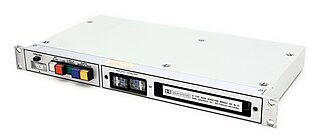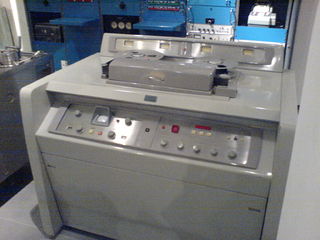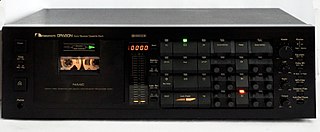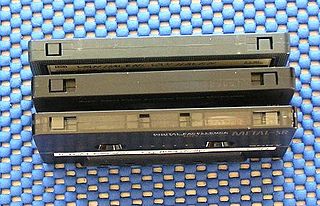
The VHS is a standard for consumer-level analog video recording on tape cassettes, introduced in 1976 by the Victor Company of Japan (JVC). It was the dominant home video format throughout the tape media period in the late 1970s, 1980s, 1990s, and early to mid 2000s.

An audio tape recorder, also known as a tape deck, tape player or tape machine or simply a tape recorder, is a sound recording and reproduction device that records and plays back sounds usually using magnetic tape for storage. In its present-day form, it records a fluctuating signal by moving the tape across a tape head that polarizes the magnetic domains in the tape in proportion to the audio signal. Tape-recording devices include the reel-to-reel tape deck and the cassette deck, which uses a cassette for storage.

A Dolby noise-reduction system, or Dolby NR, is one of a series of noise reduction systems developed by Dolby Laboratories for use in analog audio tape recording. The first was Dolby A, a professional broadband noise reduction system for recording studios in 1965, but the best-known is Dolby B, a sliding band system for the consumer market, which helped make high fidelity practical on cassette tapes, which used a relatively noisy tape size and speed. It is common on high-fidelity stereo tape players and recorders to the present day, although Dolby has as of 2016 ceased licensing the technology for new cassette decks. Of the noise reduction systems, Dolby A and Dolby SR were developed for professional use. Dolby B, C, and S were designed for the consumer market. Aside from Dolby HX, all the Dolby variants work by companding: compressing the dynamic range of the sound during recording, and expanding it during playback.
A cassette deck is a type of tape machine for playing and recording audio cassettes that does not have a built-in power amplifier or speakers, and serves primarily as a transport. It can be a part of an automotive entertainment system, a part of a portable mini system or a part of a home component system. In the latter case it is also called a component cassette deck or just a component deck.

Ampex Data Systems Corporation is an American electronics company founded in 1944 by Alexander M. Poniatoff as a spin-off of Dalmo-Victor. The name AMPEX is a portmanteau, created by its founder, which stands for Alexander M. Poniatoff Excellence. Ampex operates as Ampex Data Systems Corporation, a subsidiary of Delta Information Systems, and consists of two business units. The Silicon Valley unit, known internally as Ampex Data Systems (ADS), manufactures digital data storage systems capable of functioning in harsh environments. The Colorado Springs, Colorado, unit, referred to as Ampex Intelligent Systems (AIS), serves as a laboratory and hub for the company's line of industrial control systems, cyber security products and services and its artificial intelligence/machine learning technology.

Reel-to-reel audio tape recording, also called open-reel recording, is magnetic tape audio recording in which the recording tape is spooled between reels. To prepare for use, the supply reel containing the tape is placed on a spindle or hub. The end of the tape is manually pulled from the reel, threaded through mechanical guides and over a tape head assembly, and attached by friction to the hub of the second, initially empty takeup reel. Reel-to-reel systems use tape that is 1⁄4, 1⁄2, 1, or 2 inches wide, which normally moves at 3+3⁄4, 7+1⁄2, 15 or 30 inches per second. Domestic consumer machines almost always used 1⁄4 inch (6.35 mm) or narrower tape and many offered slower speeds such as 1+7⁄8 inches per second (4.762 cm/s). All standard tape speeds are derived as a binary submultiple of 30 inches per second.
Nakamichi Corp., Ltd. is a Japanese consumer electronics brand that originated in Japan and gained a name from the 1970s onwards for original and high quality audio cassette decks. Nakamichi is a subsidiary of Chinese holding company Nimble Holdings.

A video tape recorder (VTR) is a tape recorder designed to record and playback video and audio material from magnetic tape. The early VTRs were open-reel devices that record on individual reels of 2-inch-wide (5.08 cm) tape. They were used in television studios, serving as a replacement for motion picture film stock and making recording for television applications cheaper and quicker. Beginning in 1963, videotape machines made instant replay during televised sporting events possible. Improved formats, in which the tape was contained inside a videocassette, were introduced around 1969; the machines which play them are called videocassette recorders.
Print-through is a generally undesirable effect that arises in the use of magnetic tape for storing analog information, in particular music, caused by contact transfer of signal patterns from one layer of tape to another as it sits wound concentrically on a reel.

A tape head is a type of transducer used in tape recorders to convert electrical signals to magnetic fluctuations and vice versa. They can also be used to read credit/debit/gift cards because the strip of magnetic tape on the back of a credit card stores data the same way that other magnetic tapes do. Cassettes, reel-to-reel tapes, 8-tracks, VHS tapes, and even floppy disks and early hard drive disks all use the same principle of physics to store and read back information. The medium is magnetized in a pattern. It then moves at a constant speed over an electromagnet. Since the moving tape is carrying a changing magnetic field with it, it induces a varying voltage across the head. That voltage can then be amplified and connected to speakers in the case of audio, or measured and sorted into ones and zeroes in the case of digital data.

The Microcassette is an audio storage medium, introduced by Olympus in 1969.

U-matic or 3⁄4-inch Type E Helical Scan or SMPTE E is an analogue recording videocassette format first shown by Sony in prototype in October 1969, and introduced to the market in September 1971. It was among the first video formats to contain the videotape inside a cassette, as opposed to the various reel-to-reel or open-reel formats of the time. The videotape is 3⁄4 in (19 mm) wide, so the format is often known as "three-quarter-inch" or simply "three-quarter", compared to open reel videotape formats in use, such as 1 in (25 mm) type C videotape and 2 in (51 mm) quadruplex videotape.
The history of sound recording - which has progressed in waves, driven by the invention and commercial introduction of new technologies — can be roughly divided into four main periods:

Magnetophon was the brand or model name of the pioneering reel-to-reel tape recorder developed by engineers of the German electronics company AEG in the 1930s, based on the magnetic tape invention by Fritz Pfleumer. AEG created the world's first practical tape recorder, the K1, first demonstrated in Germany in 1935 at the Berlin Radio Show.

The 1/4 inch Akai is a portable helical scan EIA and CCIR analog recording video tape recorder (VTR) with two video record heads on the scanning drum. The units were available with an optional RF modulator to play back through a TV set, as well as a detachable video monitor. The Akai Electric Ltd. VTR plant was in Tokyo, Japan.

A sound follower, also referred to as separate magnetic, sepmag, magnetic film recorder, or mag dubber, is a device for the recording and playback of film sound that is recorded on magnetic film. This device is locked or synchronized with the motion picture film containing the picture. It operates like an analog reel-to-reel audio tape recording, but using film, not magnetic tape. The unit can be switched from manual control to sync control, where it will follow the film with picture.

The Nakamichi Dragon is an audio cassette deck that was introduced by Nakamichi in 1982 and marketed until 1994. The Dragon was the first Nakamichi model with bidirectional replay capability and the world's first production tape recorder with an automatic azimuth correction system; this feature, which was invented by Philips engineers and improved by Niro Nakamichi, continuously adjusts the azimuth of the replay head to minimize apparent head skew and correctly reproduce the treble signal present on the tape. The system allows the correct reproduction of mechanically skewed cassettes and recordings made on misaligned decks. Apart from the Dragon, similar systems have only been used in the Nakamichi TD-1200 car cassette player and the Marantz SD-930 cassette deck.

Audio compact cassettes use magnetic tape of three major types which differ in fundamental magnetic properties, the level of bias applied during recording, and the optimal time constant of replay equalization. Specifications of each type were set in 1979 by the International Electrotechnical Commission (IEC): Type I, Type II, Type III, and Type IV. 'Type 0' was a non-standard designation for early compact cassettes that did not conform to IEC specification.

The Revox B215 is a cassette deck manufactured by Studer from 1985 until around 1990. A professional version with different control layout and audio path electronics was manufactured concurrently as the Studer A721. A later improved version was marketed as the Revox B215S. Because it was expensive compared to other consumer models and had exceptionally good mechanical performance and durability, the B215 was used primarily by professional customers—radio stations, recording studios and real-time cassette duplicators.
In magnetic tape recording, adaptive biasing is the technique of continuously varying the bias current to a recording head in accordance with the level of high-frequency audio signals. With adaptive biasing, high levels of high-frequency audio signals cause a proportionate decrease in bias current using either feedforward or preferably a negative feedback control system. Compared with the use of fixed bias current, adaptive biasing provides a higher maximum output level and higher dynamic range at the upper end of the audible spectrum and to a lesser extent, mid-range frequencies. The effect of adaptive biasing is most pronounced in compact cassette and low-speed reel-to-reel media. The first commercial implementation, the feedforward system Dolby HX was developed by Dolby Laboratories by 1979 and was rejected by the industry. The subsequent negative-feedback system Dolby HX Pro was developed by Bang & Olufsen and marketed by Dolby, and became the de facto standard of the consumer high fidelity industry in the mid-1980s.













